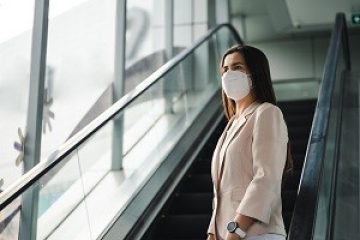FOR IMMEDIATE RELEASE

“Solid-Phase Microextraction Fiber in Face Mask for In Vivo Sampling and Direct Mass Spectrometry Analysis of Exhaled Breath Aerosol”
Analytical Chemistry
Given current events, many people are wearing face masks to protect themselves and others. But that same face mask could someday also collect useful health information. Researchers reporting in ACS’ Analytical Chemistry have demonstrated that a fiber inserted into an ordinary N95 face mask can collect compounds in exhaled breath aerosols for analysis. The new method could allow screening for disease biomarkers on a large scale.
Exhaled breath is an aerosol that contains a variety of volatile and non-volatile compounds dissolved in microdroplets. Some of these molecules could provide important health information, such as whether a person has a certain disease, or how their body metabolizes medications they’re taking. Mass spectrometry is a sensitive technique that can help identify these compounds. But first, sufficient amounts of the molecules must be collected, which often requires tedious procedures such as breathing into a tube or bag. Bin Hu and colleagues wondered if they could find a way to use face masks, which many people are wearing anyway, to collect and concentrate compounds exhaled in breath for later mass spectrometry analysis.
To test their idea, the researchers clipped a solid-phase microextraction (SPME) fiber inside an N95 face mask. SPME fibers have been used previously to extract compounds from breath collected by other methods. Volunteers performed many different activities, including eating a banana or garlic, smoking a cigarette or drinking a cup of coffee. Then, the volunteers wore the masks for 2 hours, and the researchers removed the SPME fibers and analyzed them by mass spectrometry. For each activity, the researchers detected specific compounds, even some that were present at trace amounts: for example, volatile sulfur compounds from eating garlic, nicotine from smoking and caffeine from drinking coffee. The researchers hope that the method will inspire biomarker studies for respiratory illnesses that require people to wear masks in everyday life.
The authors acknowledge funding from the National Natural Science Foundation of China and the Foundation for New Faculty Start-up Program of Jinan University.
To automatically receive press releases from the American Chemical Society, contact newsroom@acs.org.
Note: ACS does not conduct research, but publishes and publicizes peer-reviewed scientific studies.
Note: ACS does not conduct research but publishes and publicizes peer-reviewed scientific studies.





